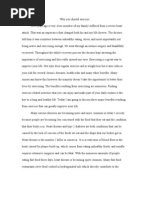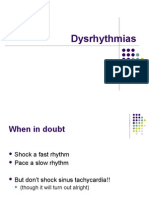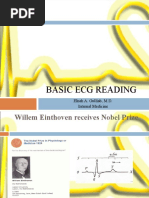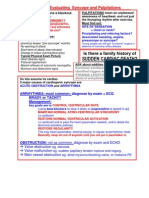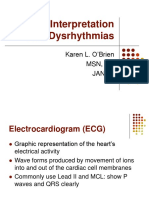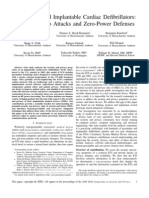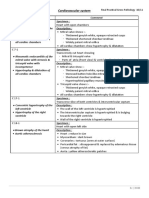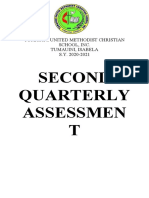0 ratings0% found this document useful (0 votes)
67 viewsEcg Readings
Ecg Readings
Uploaded by
Sasa LuarThe document describes different types of cardiac rhythms as assessed by electrocardiogram (ECG). It defines normal sinus rhythm and provides details on abnormal rhythms including sinus bradycardia, sinus tachycardia, supraventricular tachycardia, atrial fibrillation, atrial flutter, various atrioventricular blocks, bundle branch blocks, premature ventricular complexes, junctional rhythms, ventricular tachycardia, ventricular fibrillation, asystole, and myocardial infarction. For each rhythm, it lists the characteristics seen on ECG such as rhythm, rate, P wave, QRS duration, and PR interval.
Copyright:
© All Rights Reserved
Available Formats
Download as DOCX, PDF, TXT or read online from Scribd
Ecg Readings
Ecg Readings
Uploaded by
Sasa Luar0 ratings0% found this document useful (0 votes)
67 views10 pagesThe document describes different types of cardiac rhythms as assessed by electrocardiogram (ECG). It defines normal sinus rhythm and provides details on abnormal rhythms including sinus bradycardia, sinus tachycardia, supraventricular tachycardia, atrial fibrillation, atrial flutter, various atrioventricular blocks, bundle branch blocks, premature ventricular complexes, junctional rhythms, ventricular tachycardia, ventricular fibrillation, asystole, and myocardial infarction. For each rhythm, it lists the characteristics seen on ECG such as rhythm, rate, P wave, QRS duration, and PR interval.
Original Description:
a
Copyright
© © All Rights Reserved
Available Formats
DOCX, PDF, TXT or read online from Scribd
Share this document
Did you find this document useful?
Is this content inappropriate?
The document describes different types of cardiac rhythms as assessed by electrocardiogram (ECG). It defines normal sinus rhythm and provides details on abnormal rhythms including sinus bradycardia, sinus tachycardia, supraventricular tachycardia, atrial fibrillation, atrial flutter, various atrioventricular blocks, bundle branch blocks, premature ventricular complexes, junctional rhythms, ventricular tachycardia, ventricular fibrillation, asystole, and myocardial infarction. For each rhythm, it lists the characteristics seen on ECG such as rhythm, rate, P wave, QRS duration, and PR interval.
Copyright:
© All Rights Reserved
Available Formats
Download as DOCX, PDF, TXT or read online from Scribd
Download as docx, pdf, or txt
0 ratings0% found this document useful (0 votes)
67 views10 pagesEcg Readings
Ecg Readings
Uploaded by
Sasa LuarThe document describes different types of cardiac rhythms as assessed by electrocardiogram (ECG). It defines normal sinus rhythm and provides details on abnormal rhythms including sinus bradycardia, sinus tachycardia, supraventricular tachycardia, atrial fibrillation, atrial flutter, various atrioventricular blocks, bundle branch blocks, premature ventricular complexes, junctional rhythms, ventricular tachycardia, ventricular fibrillation, asystole, and myocardial infarction. For each rhythm, it lists the characteristics seen on ECG such as rhythm, rate, P wave, QRS duration, and PR interval.
Copyright:
© All Rights Reserved
Available Formats
Download as DOCX, PDF, TXT or read online from Scribd
Download as docx, pdf, or txt
You are on page 1of 10
Normal Sinus Rhythm
Looking at the ECG you'll see that:
Rhythm - Regular
Rate - (60-100 bpm)
QRS Duration - Normal
P Wave - Visible before each QRS complex
P-R Interval - Normal (<5 small Squares. Anything above and this would be 1st degree
block)
Indicates that the electrical signal is generated by the sinus node and travelling in a
normal fashion in the heart.
Sinus Bradycardia
A heart rate less than 60 beats per minute (BPM). This in a healthy athletic person may
be 'normal', but other causes may be due to increased vagal tone from drug abuse,
hypoglycaemia and brain injury with increase intracranial pressure (ICP) as examples
Looking at the ECG you'll see that:
Rhythm - Regular
Rate - less than 60 beats per minute
QRS Duration - Normal
P Wave - Visible before each QRS complex
P-R Interval - Normal
Usually benign and often caused by patients on beta blockers
Sinus Tachycardia
An excessive heart rate above 100 beats per minute (BPM) which originates from the SA
node. Causes include stress, fright, illness and exercise. Not usually a surprise if it is
triggered in response to regulatory changes e.g. shock. But if their is no apparent trigger
then medications may be required to suppress the rhythm
Looking at the ECG you'll see that:
Rhythm - Regular
Rate - More than 100 beats per minute
QRS Duration - Normal
P Wave - Visible before each QRS complex
P-R Interval - Normal
The impulse generating the heart beats are normal, but they are occurring at a faster
pace than normal. Seen during exercise
Supraventricular Tachycardia (SVT) Abnormal
A narrow complex tachycardia or atrial tachycardia which originates in the 'atria' but is
not under direct control from the SA node. SVT can occur in all age groups
Looking at the ECG you'll see that:
Rhythm - Regular
Rate - 140-220 beats per minute
QRS Duration - Usually normal
P Wave - Often buried in preceding T wave
P-R Interval - Depends on site of supraventricular pacemaker
Impulses stimulating the heart are not being generated by the sinus node, but instead
are coming from a collection of tissue around and involving the atrioventricular (AV) node
Atrial Fibrillation
Many sites within the atria are generating their own electrical impulses, leading to
irregular conduction of impulses to the ventricles that generate the heartbeat. This
irregular rhythm can be felt when palpating a pulse
Looking at the ECG you'll see that:
Rhythm - Irregularly irregular
Rate - usually 100-160 beats per minute but slower if on medication
QRS Duration - Usually normal
P Wave - Not distinguishable as the atria are firing off all over
P-R Interval - Not measurable
The atria fire electrical impulses in an irregular fashion causing irregular heart rhythm
Atrial Flutter
Looking at the ECG you'll see that:
Rhythm - Regular
Rate - Around 110 beats per minute
QRS Duration - Usually normal
P Wave - Replaced with multiple F (flutter) waves, usually at a ratio of 2:1 (2F - 1QRS)
but sometimes 3:1
P Wave rate - 300 beats per minute
P-R Interval - Not measurable
As with SVT the abnormal tissue generating the rapid heart rate is also in the atria,
however, the atrioventricular node is not involved in this case.
1st Degree AV Block
1st Degree AV block is caused by a conduction delay through the AV node but all
electrical signals reach the ventricles. This rarely causes any problems by itself and often
trained athletes can be seen to have it. The normal P-R interval is between 0.12s to
0.20s in length, or 3-5 small squares on the ECG.
Looking at the ECG you'll see that:
Rhythm - Regular
Rate - Normal
QRS Duration - Normal
P Wave - Ratio 1:1
P Wave rate - Normal
P-R Interval - Prolonged (>5 small squares)
2nd Degree Block Type 1 (Wenckebach)
Another condition whereby a conduction block of some, but not all atrial beats getting
through to the ventricles. There is progressive lengthening of the PR interval and then
failure of conduction of an atrial beat, this is seen by a dropped QRS complex.
Looking at the ECG you'll see that:
Rhythm - Regularly irregular
Rate - Normal or Slow
QRS Duration - Normal
P Wave - Ratio 1:1 for 2,3 or 4 cycles then 1:0.
P Wave rate - Normal but faster than QRS rate
P-R Interval - Progressive lengthening of P-R interval until a QRS complex is dropped
2nd Degree Block Type 2
When electrical excitation sometimes fails to pass through the A-V node or bundle of His,
this intermittent occurance is said to be called second degree heart block. Electrical
conduction usually has a constant P-R interval, in the case of type 2 block atrial
contractions are not regularly followed by ventricular contraction
Looking at the ECG you'll see that:
Rhythm - Regular
Rate - Normal or Slow
QRS Duration - Prolonged
P Wave - Ratio 2:1, 3:1
P Wave rate - Normal but faster than QRS rate
P-R Interval - Normal or prolonged but constant
3rd Degree Block
3rd degree block or complete heart block occurs when atrial contractions are 'normal' but
no electrical conduction is conveyed to the ventricles. The ventricles then generate their
own signal through an 'escape mechanism' from a focus somewhere within the ventricle.
The ventricular escape beats are usually 'slow'
Looking at the ECG you'll see that:
Rhythm - Regular
Rate - Slow
QRS Duration - Prolonged
P Wave - Unrelated
P Wave rate - Normal but faster than QRS rate
P-R Interval - Variation
Complete AV block. No atrial impulses pass through the atrioventricular node and the
ventricles generate their own rhythm
Bundle Branch Block
Abnormal conduction through the bundle branches will cause a depolarization delay
through the ventricular muscle, this delay shows as a widening of the QRS complex. Right
Bundle Branch Block (RBBB) indicates problems in the right side of the heart. Whereas
Left Bundle Branch Block (LBBB) is an indication of heart disease. If LBBB is present then
further interpretation of the ECG cannot be carried out.
Looking at the ECG you'll see that:
Rhythm - Regular
Rate - Normal
QRS Duration - Prolonged
P Wave - Ratio 1:1
P Wave rate - Normal and same as QRS rate
P-R Interval - Normal
Premature Ventricular Complexes
Due to a part of the heart depolarizing earlier than it should
Looking at the ECG you'll see that:
Rhythm - Regular
Rate - Normal
QRS Duration - Normal
P Wave - Ratio 1:1
P Wave rate - Normal and same as QRS rate
P-R Interval - Normal
Also you'll see 2 odd waveforms, these are the ventricles depolarising prematurely in
response to a signal within the ventricles.(Above - unifocal PVC's as they look alike if they
differed in appearance they would be called multifocal PVC's, as below)
Junctional Rhythms
Looking at the ECG you'll see that:
Rhythm - Regular
Rate - 40-60 Beats per minute
QRS Duration - Normal
P Wave - Ratio 1:1 if visible. Inverted in lead II
P Wave rate - Same as QRS rate
P-R Interval - Variable
Below - Accelerated Junctional Rhythm
Ventricular Tachycardia (VT) Abnormal
Looking at the ECG you'll see that:
Rhythm - Regular
Rate - 180-190 Beats per minute
QRS Duration - Prolonged
P Wave - Not seen
Results from abnormal tissues in the ventricles generating a rapid and irregular heart
rhythm. Poor cardiac output is usually associated with this rhythm thus causing the pt to
go into cardiac arrest. Shock this rhythm if the patient is unconscious and without a pulse
Ventricular Fibrillation (VF) Abnormal
Disorganised electrical signals cause the ventricles to quiver instead of contract in a
rhythmic fashion. A patient will be unconscious as blood is not pumped to the brain.
Immediate treatment by defibrillation is indicated. This condition may occur during or
after a myocardial infarct.
Looking at the ECG you'll see that:
Rhythm - Irregular
Rate - 300+, disorganised
QRS Duration - Not recognisable
P Wave - Not seen
This patient needs to be defibrillated!! QUICKLY
Asystole - Abnormal
Looking at the ECG you'll see that:
Rhythm - Flat
Rate - 0 Beats per minute
QRS Duration - None
P Wave - None
Carry out CPR!!
Myocardial Infarct (MI)
Looking at the ECG you'll see that:
Rhythm - Regular
Rate - 80 Beats per minute
QRS Duration - Normal
P Wave - Normal
S-T Element does not go isoelectric which indicates infarction
You might also like
- (The European Society of Cardiology Series) Marco Tubaro (Editor), Pascal Vranckx (Editor), Susanna Price (Editor), Christiaan Vrints (Editor), Eric Bonnefoy (Editor) - The ESC Textbook of Intensive ADocument1,088 pages(The European Society of Cardiology Series) Marco Tubaro (Editor), Pascal Vranckx (Editor), Susanna Price (Editor), Christiaan Vrints (Editor), Eric Bonnefoy (Editor) - The ESC Textbook of Intensive AEdu Martins100% (2)
- Why You Should Exercise - Persuasive SpeechDocument3 pagesWhy You Should Exercise - Persuasive Speechbrittbivins75% (4)
- The 12-Lead Electrocardiogram for Nurses and Allied ProfessionalsFrom EverandThe 12-Lead Electrocardiogram for Nurses and Allied ProfessionalsNo ratings yet
- ECG AbnormalitiesDocument9 pagesECG Abnormalitiesbigabm062No ratings yet
- Answer Diagnosis: 1. RhythmDocument2 pagesAnswer Diagnosis: 1. RhythmSuggula Vamsi KrishnaNo ratings yet
- 7.5.2016 IBHRE CCDS Physician 17 - FINAL PDFDocument8 pages7.5.2016 IBHRE CCDS Physician 17 - FINAL PDFAlexander Edo TondasNo ratings yet
- Cardiovascular Disorders Concept MapDocument4 pagesCardiovascular Disorders Concept MapZairaNo ratings yet
- Normal Sinus RhythmDocument8 pagesNormal Sinus RhythmRosalyn YuNo ratings yet
- Normal Sinus RhythmDocument10 pagesNormal Sinus RhythmNakul GaurNo ratings yet
- Ecg Rhythms: Normal Sinus RhythmDocument10 pagesEcg Rhythms: Normal Sinus RhythmJethJayme100% (1)
- Ecg RhythmsDocument9 pagesEcg RhythmsNoreena PrincessNo ratings yet
- Rhythm Interpretation and Its ManagementDocument6 pagesRhythm Interpretation and Its Managementjh_ajjNo ratings yet
- 5 Steps To Rhythm Strip InterpretationDocument2 pages5 Steps To Rhythm Strip Interpretationjosh082572No ratings yet
- Abnormal EcgDocument8 pagesAbnormal EcgM.DalaniNo ratings yet
- ECG 2 KidsDocument72 pagesECG 2 KidsRonald Rey GarciaNo ratings yet
- ECG Rythum Study Guide PDFDocument9 pagesECG Rythum Study Guide PDFArtika MayandaNo ratings yet
- Mitral Valve Regurgitation, A Simple Guide To The Condition, Treatment And Related ConditionsFrom EverandMitral Valve Regurgitation, A Simple Guide To The Condition, Treatment And Related ConditionsNo ratings yet
- EKG and ECG Interpretation: Learn EKG Interpretation, Rhythms, and Arrhythmia Fast!From EverandEKG and ECG Interpretation: Learn EKG Interpretation, Rhythms, and Arrhythmia Fast!No ratings yet
- Asystole, (Flatliner) A Simple Guide To The Condition, Diagnosis, Treatment And Related ConditionsFrom EverandAsystole, (Flatliner) A Simple Guide To The Condition, Diagnosis, Treatment And Related ConditionsNo ratings yet
- Ectopic Heartbeats, (Extrasystoles) A Simple Guide To The Condition, Diagnosis, Treatment And Related ConditionsFrom EverandEctopic Heartbeats, (Extrasystoles) A Simple Guide To The Condition, Diagnosis, Treatment And Related ConditionsNo ratings yet
- ECG (Rythm Interpretation)Document39 pagesECG (Rythm Interpretation)RatnaSuryati100% (1)
- Basic Ecg: in The Eyes of NURSEDocument112 pagesBasic Ecg: in The Eyes of NURSESam jr TababaNo ratings yet
- Ekg Panum or OsceDocument69 pagesEkg Panum or OsceGladish RindraNo ratings yet
- Basics and Interpretation: Sif HansdottirDocument65 pagesBasics and Interpretation: Sif Hansdottirwenny1186100% (1)
- Dave DysrhythmiasDocument66 pagesDave Dysrhythmiasdaveplummermd100% (1)
- DR Kupe - ECGDocument14 pagesDR Kupe - ECGIrfan ZiadNo ratings yet
- Brugada SyndromeDocument1 pageBrugada SyndromecyelzNo ratings yet
- Report EcgDocument144 pagesReport EcgPeace Andong PerochoNo ratings yet
- Arrhythmias: Sing Khien Tiong Gpst1Document34 pagesArrhythmias: Sing Khien Tiong Gpst1preethi preethaNo ratings yet
- EKG Interpretation: UNS Cardiovascular Dept Medical Student Lecture SeriesDocument85 pagesEKG Interpretation: UNS Cardiovascular Dept Medical Student Lecture Seriesandina rosmalianti100% (1)
- ECG Master Class-1Document132 pagesECG Master Class-1Shohag ID Center100% (1)
- EKG - Assignment Without AnswersDocument10 pagesEKG - Assignment Without AnswersJon Millhollon100% (1)
- Temporary Pacemakers-SICU's 101 PrimerDocument51 pagesTemporary Pacemakers-SICU's 101 Primerwaqas_xsNo ratings yet
- ECG Interpretation UnismaDocument178 pagesECG Interpretation UnismadefinaNo ratings yet
- EKG Interpretation: DR K P Tripathy Kims, BhubaneswarDocument58 pagesEKG Interpretation: DR K P Tripathy Kims, BhubaneswarAbhilash MohantyNo ratings yet
- Electrocardiogram (E.C.G)Document51 pagesElectrocardiogram (E.C.G)Jamuna PatelNo ratings yet
- Chapter - 036 Arrhythmias ClassDocument129 pagesChapter - 036 Arrhythmias ClassWisdomIsMiseryNo ratings yet
- Ngaji Arrythmia Cordis 3Document122 pagesNgaji Arrythmia Cordis 3Dhita Dwi NandaNo ratings yet
- Basic Ecg Reading - McuDocument63 pagesBasic Ecg Reading - McuJofandAndrea MendozaNo ratings yet
- Cardiology - Dr. Allam 2021Document141 pagesCardiology - Dr. Allam 2021MohammedNo ratings yet
- DR K Chan - Ecg For SVT Made EasyDocument66 pagesDR K Chan - Ecg For SVT Made Easyapi-346486620No ratings yet
- TelemetryDocument3 pagesTelemetryKelly PrattNo ratings yet
- Sinus Rhythm DisturbancesDocument3 pagesSinus Rhythm DisturbancesMarcus Philip GonzalesNo ratings yet
- Advanced ICD Troubleshooting Part 2 PACE 2006 PDFDocument27 pagesAdvanced ICD Troubleshooting Part 2 PACE 2006 PDFSrajner PéterNo ratings yet
- ElectrocardiogramDocument52 pagesElectrocardiogramTuong HoangManhNo ratings yet
- Focal Atrial Tachycardia I: Clinical Features, DiagnosisDocument10 pagesFocal Atrial Tachycardia I: Clinical Features, Diagnosisapi-26166949No ratings yet
- ElectrocardiogramDocument169 pagesElectrocardiogramjitendra magarNo ratings yet
- ArrhyDocument26 pagesArrhyMouriyan AmanNo ratings yet
- ECG WorldDocument139 pagesECG WorldsatyaNo ratings yet
- Advanced ECG BBB PGDocument47 pagesAdvanced ECG BBB PGdragon66No ratings yet
- ACLS RhythmsDocument2 pagesACLS RhythmsValerie BatesNo ratings yet
- Sally Aburumman Bushra SaleemDocument75 pagesSally Aburumman Bushra SaleemAbdulrahman AlsayyedNo ratings yet
- Prehospital Use of Tranexamic Acid (TXA) For Major BleedingDocument19 pagesPrehospital Use of Tranexamic Acid (TXA) For Major Bleedingandrew22No ratings yet
- EkgDocument67 pagesEkgFendi Rafif Dad'sNo ratings yet
- Syncope and PalpitationsDocument1 pageSyncope and PalpitationsTom MallinsonNo ratings yet
- ECG Interpretation and Dysrhythmias: Karen L. O'Brien MSN, RN JAN 07Document60 pagesECG Interpretation and Dysrhythmias: Karen L. O'Brien MSN, RN JAN 07ampogison08No ratings yet
- PaceMaker HAckingDocument14 pagesPaceMaker HAckingRemi BlanchetteNo ratings yet
- ECG Interpretations GoodDocument104 pagesECG Interpretations GoodaymenNo ratings yet
- ICD Troubleshooting (Heart)Document13 pagesICD Troubleshooting (Heart)Prem KumarNo ratings yet
- Fuentes, AlvinoDocument6 pagesFuentes, AlvinoJaphet RacaNo ratings yet
- فەرهەنگی پزیشکی من (Kaka)Document120 pagesفەرهەنگی پزیشکی من (Kaka)mrben2596No ratings yet
- 7-Cardiology and Respiratory MedicineDocument373 pages7-Cardiology and Respiratory Medicinethisar100% (6)
- 10 General Anatomy of The Cardiovascular SystemDocument140 pages10 General Anatomy of The Cardiovascular SystemSuzana Voiculescu100% (1)
- Cardiovascular SystemDocument3 pagesCardiovascular Systemhz1588No ratings yet
- Instant Download Basics: A Comprehensive Outline of Nursing School Content Kaplan Nursing PDF All ChaptersDocument65 pagesInstant Download Basics: A Comprehensive Outline of Nursing School Content Kaplan Nursing PDF All Chapterstaycirmebri100% (3)
- Try Out CompilationDocument17 pagesTry Out CompilationRendi RafsanjaniNo ratings yet
- Pathfit Second DiscussionDocument22 pagesPathfit Second DiscussionxioncolvarNo ratings yet
- English 6 Unit TestDocument14 pagesEnglish 6 Unit Testjaypee ruiz someraNo ratings yet
- Central Venous Catheterization: Maret 2021Document39 pagesCentral Venous Catheterization: Maret 2021Rudy SiahaanNo ratings yet
- 220 Triathlon UK - January 2024Document120 pages220 Triathlon UK - January 2024Omar Magdy AhmadNo ratings yet
- Physiology of The Cardiovascular System-CVSDocument56 pagesPhysiology of The Cardiovascular System-CVSAmanuel MaruNo ratings yet
- Heal Your Emotions BookletDocument57 pagesHeal Your Emotions BookletPriyanka100% (2)
- Clinical Epidemiology of Heart Failure: Arend Mosterd, Arno W HoesDocument11 pagesClinical Epidemiology of Heart Failure: Arend Mosterd, Arno W HoesCAMILO ANDRES TOVAR DAZANo ratings yet
- Dysrhythmia NotesDocument4 pagesDysrhythmia NotesJohiarra TabigneNo ratings yet
- CCRH New Course1 - SuDocument99 pagesCCRH New Course1 - Suabcxyz15021999No ratings yet
- Ganotherapy by Dr. Lim Sio JinDocument22 pagesGanotherapy by Dr. Lim Sio JinSyed Zafar Abbas Jafri100% (13)
- The Effect of Exercise On Cardiovascular Activity in HumansDocument11 pagesThe Effect of Exercise On Cardiovascular Activity in HumansnbwassamNo ratings yet
- Diskusi 04 Reading 03Document2 pagesDiskusi 04 Reading 03Heru TamyizNo ratings yet
- NCLEX Study MaterialDocument40 pagesNCLEX Study MaterialChristie GerconNo ratings yet
- Complete Download Textbook of Medical Physiology 4th Edition - Ebook Gopal Krushna Pal PDF All ChaptersDocument57 pagesComplete Download Textbook of Medical Physiology 4th Edition - Ebook Gopal Krushna Pal PDF All Chaptersbehanaamonov100% (1)
- Pir December 2023Document62 pagesPir December 2023ceciliagandulfoNo ratings yet
- Pathophysiology of Arrhythmias: Belay E. MD December 2015Document53 pagesPathophysiology of Arrhythmias: Belay E. MD December 2015Amanuel MaruNo ratings yet
- A Phase I Feasibility Study of Yoga On The Physical Health and Coping of Informal CaregiversDocument11 pagesA Phase I Feasibility Study of Yoga On The Physical Health and Coping of Informal CaregiversFranco EliasNo ratings yet
- 12A BT Điền Từ - Đục Lỗ (10 Bài)Document7 pages12A BT Điền Từ - Đục Lỗ (10 Bài)Class LaceyNo ratings yet
- Hubungan Penyakit Jantung Bawaan Dengan Status Gizi Pada Anak Di Rsup Prof. Dr. R. D. Kandou Manado TAHUN 2009-2013Document8 pagesHubungan Penyakit Jantung Bawaan Dengan Status Gizi Pada Anak Di Rsup Prof. Dr. R. D. Kandou Manado TAHUN 2009-2013NATALIA CHARISMA LIANA WARFANDUNo ratings yet
- Inotropes in Critical Care UnitDocument48 pagesInotropes in Critical Care UnitKelvin Christopher Ker100% (1)

